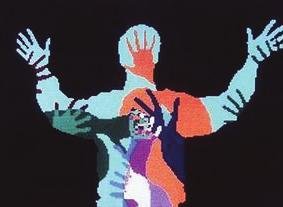Read the whole essay.
‘The Simple Expression of Complex Thought’: For a Media Theory of Expression
Editorial content |
Submitted by mute on Tuesday, 28 April, 2009 - 16:54
M. Beatrice FaziIn light of the postmodernist cul-de-sac of relativism which, for all its social constructivism, cannot escape crude causality, M. Beatrice Fazi proposes a metaphysics of difference for decoding expression in interactive media
While walking through a recent Rothko exhibition at the Tate Modern, the audio guide I was provided with tells the story of how Mark Rothko disliked the label ‘abstract expressionist' assigned to him by the critics because he didn't consider his paintings to be unreal compositions (abstract), nor private accounts of his internal emotional life (expressionist). His big, feathered, flooding patches of colour are, in fact, a subtle dynamic of existing processes and materials. No intimate details of the artist's subjectivity are to be found, but layer after layer of imperceptible paint as ‘the simple expression of complex thought.'1
All images from Myron Krueger's Videoplace, 1974
This anecdote per se is rather fascinating, for it concisely and interestingly pinpoints two common misconceptions concerning both abstraction and expressivity. Generally speaking, that which is ‘abstract' is understood as the non-figurative, the symbolic, the transcendent. Fiercely independent from concrete references to the world, abstraction is, for this reason, denied external reality and confined to an imaginary of internal recursive significations. ‘Expression', on the other hand, is the exposed, the spoken, the gestural or, in other words, the communicated qualities of inner experience in all its emphasis and distortion through vivid emotional utterance.
From art history to cultural theory via daily practices of common sense, such denotations seem to stand firm through a large part of contemporary social phenomena, which inevitably involve and develop into discourses on technologisation and digitality. With their capacity for mediation and re-mediation, these latter form the ultimate outposts of communicational practices of mass expressivity on the one hand, or, abstract corporeal decay and immaterial representation on the other.
Translated into practices of ‘interaction' (a word so burdened and inflated to have become, as Massumi splendidly comments, a proper regime of tyranny2), the ‘user' is, from this perspective, a sort of strange creature in between a behaviourist Golem, pushing buttons and waiting for feedback, and a transcendental ego of Kantian reminiscence, positing itself and its relation to technology as a world-creating operation of knowledge. Whether adding a layer in Photoshop or jacking into that fictional dimension formerly known as cyberspace, expressivity and its cognates do not seem to go much further than the limits of their own subjectivising instantiations. In other words, expression becomes a designative rapport between the intentionality of a subject and the phenomenality of such a transmission of information. Interactive practices, in this sense, are organised around the more or less conscious or intelligent will of their actors, whether humans or machines.
According to what can arguably be called a ‘communicational' understanding of expression, the user's knowledge and intentions are the basic premises against which to model the semantics of the interactive system.3 Such levels of cognitive representations, then, are called ‘abstractions' for they involve thought ? or, better, rationality ? as a means to formulate a plan of action and consequently evaluate the results. What is affirmed, in this perspective, is the referential function of expression intended as causal transmission of some sort of content from a subject A to an object B. In turn, ‘abstraction' is a tool with which to perform, simplify or support such a communicative task, allowing logical systems to be reasoned out. Whenever, for instance, I decide to upload my holiday pictures on the next best social networking website, my establishing the goal, specifying the intention, executing the action, sequence and finally judging the system's state all become subjective, expressive acts, whose legitimacy and efficacy are guaranteed by a logically antecedent content to be expressed by means of abstract thought processes, where ‘ideas' are distanced from their referent ‘objects'. This is, indeed, also a quite traditional and very common framework in a large part of Human-Computer Interaction.4 Designers of software and hardware aim to create computational products for people who have specific tasks in mind and who want to use machines in a way that is supposedly fluid in respect to their functions, so translating ‘abstract' knowledge into an executable system. If we now look again at the aforementioned example of the ‘upload picture' function of a social networking site, we will see then that it can be said to work exactly in accordance with such HCI principles. Expressivity, thus, is supposedly established by the user's own path through windowing systems, cursor indicators and all the technological features that are meant to present or represent a mirroring or moulding of his/her intentionality.
Offering multiple perspectives from many fields of human inquiry that may move all of us toward a more integrated understanding of who we are as conscious beings.
Tuesday, June 09, 2009
Mute - ‘The Simple Expression of Complex Thought’: For a Media Theory of Expression
Mute Magazine posted this article on ‘The Simple Expression of Complex Thought’: For a Media Theory of Expression. Good stuff, in a geeky academic navel-gazing kind of way.
Tags:
Subscribe to:
Post Comments (Atom)

No comments:
Post a Comment